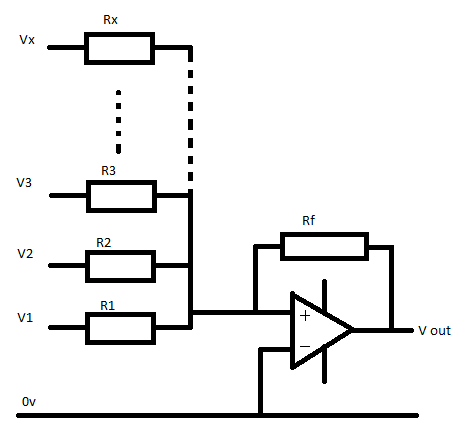I've kind of stayed away from saying here's an amplifier, because, simply, I already gave the circuits, inverting/non-inverting, there you go, pick resistors to set the gain and build voila a simple amplifier.
What I'm going to look at in this lesson is an amplifier that's a little more complicated.
Summing amplifiers
Summing amplifiers are essentially amplifiers that take a signal and produce it's sum.
they are inverting amplifiers so bear in mind that the sum is negative, and would need to be flipped by a final amplifier.
If you take an example amplifier with two inputs:
The voltage on input 1 = 1, and the input on input 2 = 5, we'd expect the output of the amplifier (assuming gain=1) to be -6, 1+5 = -6 (minus 6 because it's inverted)
Resistor networks
As you may have guessed the output voltage of the summing amplifier is dependant on a network of resistors, and (yay) more maths...
the voltage at the out put is
Vout = -Rf ((v1/v1) + (v2/r2) (and so on))
if we make all the resistors 10Ohms we have
v out = -10 x ((1/10) + (5/10))
vOut = -10 x (0.1 + 0.5)
vOut = -10 x 0.6 = -6 (just like in the above example)
if we have three resistors the equations will be
vout = -Rfeedback x ((v1/r1) + (v2/r2) + (v3/r3))
The summing amplifier is infinity expandable, and is a critical component of a mixing desk.
an 8 channel mixing desk is simply an 8 channel summing amplifier.
Loud switch
Lets assume that we have a two channel amplifier.
the voltages at input 1 are both 1volt signals.
R1 = 10Ohms
R2 = 10Ohms
R3 = 5Ohms
RF = 10 Ohms
There is a switch that will select wither the 5 or 10 Ohm resistor for V2
the output looks like this
Vout = -10 (1/10 + 1/10) = -2
and when the "loud" switch is pressed on channel 2 it looks like this
Vout = -10 ( 1/10 + 1/5) = -3
that 3 volt output is made of 1 x v1 and 2 x v2 so we see the signal on channel 2 (that is V2) now appears twice as loud as the source attached to V1


No comments:
Post a Comment